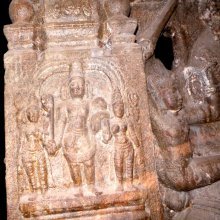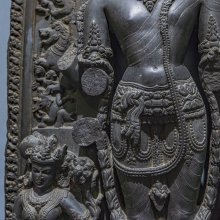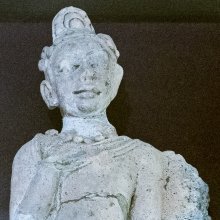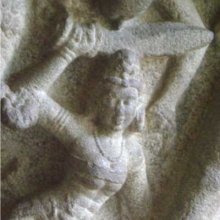Waist: 2 definitions
Introduction:
Waist means something in Hinduism, Sanskrit. If you want to know the exact meaning, history, etymology or English translation of this term then check out the descriptions on this page. Add your comment or reference to a book if you want to contribute to this summary article.
Images (photo gallery)
(+42 more images available)
In Hinduism
Natyashastra (theatrics and dramaturgy)
Source: Shodhganga: Elements of Art and Architecture in the Trtiyakhanda of the Visnudharmottarapurana (natya)1) The Waist refers to one of the major Body Parts with which are associated various gestures and expressions (in Sanskrit Dramas), as conveyed through Āṅgikābhinaya: one of the four divisions of Abhinaya or “ways to convey or represent one’s emotion to others”, according to the Nāṭyaśāstra and the Viṣṇudharmottarapurāṇa, an ancient Sanskrit text which (being encyclopedic in nature) deals with a variety of cultural topics such as arts, architecture, music, grammar and astronomy.—The āṅgikābhinaya includes the histrionic representation of the limbs which is simply known as physical gestures. The aṅgas i.e., major classification of the body parts are six in numbers viz., head, hands, chest, sides, waist and feet.
Five types of Waist movements are accepted in the Viṣṇudharmottarapurāṇa. These are—
- prakampitā,
- vicchinā,
- nivṛttā,
- recitā and
- udvāhitā.
2) The Waist (of a person) is associated with Ardhacandra-hasta: one of the twenty-two Single-hand Gestures (in Indian Dramas) (known as asaṃyuktahastas), according to the Viṣṇudharmottarapurāṇa.—The posture of ardhacandra-hasta, as stated in the Viṣṇudharmottarapurāṇa is similar with the mayurahasta as found in the Abhinayadarpaṇa. According to the Viṣṇudharmottarapurāṇa, the ardhacandra-hasta is used to show growing moon. Moreover, it also identifies a child, a tree named Tāla, the waist part of a person etc. The acting of putting ear-rings is also showed with this hastamudrā.

Natyashastra (नाट्यशास्त्र, nāṭyaśāstra) refers to both the ancient Indian tradition (shastra) of performing arts, (natya—theatrics, drama, dance, music), as well as the name of a Sanskrit work dealing with these subjects. It also teaches the rules for composing Dramatic plays (nataka), construction and performance of Theater, and Poetic works (kavya).
Vastushastra (architecture)
Source: Shodhganga: Elements of Art and Architecture in the Trtiyakhanda of the Visnudharmottarapurana (vastu)The Waist part of the Temple (in ancient Indian architecture) is denoted by the Sanskrit term Kaṭi, as described in literature such as the Viṣṇudharmottarapurāṇa, an ancient Sanskrit text which (being encyclopedic in nature) deals with a variety of cultural topics such as arts, architecture, music, grammar and astronomy.—Temples like saumudga, nandī, vṛtta, vṛṣa etc. were constructed in circular or round shape. According to Viṣṇudharmottarapurāṇa, the kaṭi i.e., waist part and the mekhalā i.e., the slop of the digvandha type of temple should be made in circular shape. Ānanda type of temple should be constructed in square or circular shape.
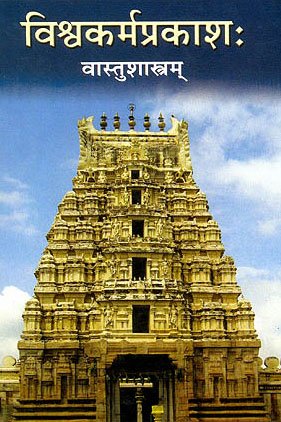
Vastushastra (वास्तुशास्त्र, vāstuśāstra) refers to the ancient Indian science (shastra) of architecture (vastu), dealing with topics such architecture, sculpture, town-building, fort building and various other constructions. Vastu also deals with the philosophy of the architectural relation with the cosmic universe.
See also (Relevant definitions)
Ends with: Great waist.
Full-text (+695): Kati, Nivi, Tanumadhya, Madhya, Avalagna, Sumadhyama, Valagna, Vilagna, Katisutra, Kamarapatta, Aroha, Madhyasthala, Khoncana, Gomadhyamadhya, Madhyabhaga, Kamarabanda, Anucchada, Lanja, Madhyadesha, Piniyolai.
Relevant text
Search found 176 books and stories containing Waist; (plurals include: Waists). You can also click to the full overview containing English textual excerpts. Below are direct links for the most relevant articles:
Temples of Munnur (Historical Study) (by R. Muthuraman)
Images of Dvarapalas < [Chapter 5]
Images of Brahma < [Chapter 5]
Introduction: The Sculpture Art of the Munnur Temples < [Chapter 5]
Pallava period (Social and Cultural History) (by S. Krishnamurthy)
Waist-band (Kati-sutra) < [Chapter 4 - Material Culture of the People]
Waist Ornaments (Introduction) < [Chapter 4 - Material Culture of the People]
Dressing style of Men < [Chapter 4 - Material Culture of the People]
Remembering the Day < [July – September, 1994]
All for the Dear Motherland < [July – September, 1999]
Two Poems < [October 1958]
Chapter 7 - Duryodhana Embarassed at the Palace of King Yudhisthira < [Sabha Parva]
Chapter 2 - Discussions of Peace Between the Pandavas and the Kauravas < [Udyoga Parva]
The Religion and Philosophy of Tevaram (Thevaram) (by M. A. Dorai Rangaswamy)
Chapter 26 - Thiruppainjeeli or Tiruppainnili (Hymn 36) < [Volume 3.3 - Pilgrim’s progress: to Chola (later?)]
Chapter 4.6 - (j) Symbology of the dress < [Volume 2 - Nampi Arurar and Mythology]
Chapter 2 - Thiruthuraiyur or Tirutturaiyur (Hymn 13) < [Volume 3.1 - Pilgrim’s progress: to Arur]
Yoga Vasistha [English], Volume 1-4 (by Vihari-Lala Mitra)
Chapter XXXIII - Association of aerial and earthly beings < [Book I - Vairagya khanda (vairagya khanda)]
Chapter XXVIII - The renewed battle of the gods and demons < [Book IV - Sthiti prakarana (sthiti prakarana)]
Chapter XLIX - Description of daivastras or supernatural weapons < [Book III - Utpatti khanda (utpatti khanda)]
Related products
